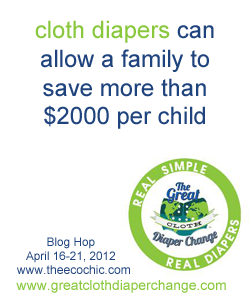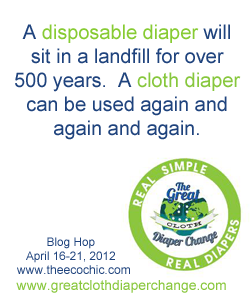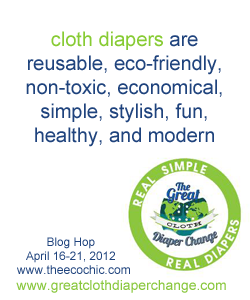I am a cloth diapering mother of a very active 7 month old girl. We love spending our time outside hiking, singing and working in the yard. We try to live a green lifestyle as much as possible. I blog about my daily adventures with my daughter on my blog Adventures in Mothering.
Fostering a love of the outdoors in our children can start from the moment they are born. A great way to foster this love is through hiking. It is an activity that you can participate in year round.
Hiking is a great way to burn off that extra pregnancy weight while bonding with your child. Hiking also gets you out of the house and is a great way to meet other new moms. I also find that if my daughter is having a rough day, if we head out for a hike, spirits are lifted and she is happy as can be. Hiking gives little ones the chance to start learning about the world around them and stimulates their brains immensely without over stimulating them. It can have a calming effect on them.
Not much is needed to get started - all you need is a good pair of shoes (make sure they have a decent grip) and a baby carrier. A walking stick can also be handy if you will be hiking on any trails with hills just to give you some support to help prevent falls.
When looking at a carrier you will want to find one that is going to give you the most bang for your buck. To do this you want to look at the weight and height limits for your baby, the age at which the baby can go in the carrier as well as what size bodies the carrier can fit (your size). There are many options out there. I recommend a soft carrier to start that can accommodate a newborn to toddler (it will go from front to back). Some prefer using a wrap for the first couple of months. These are great when your little one is small if they are born during warmer months. I prefer the soft carrier for the colder months since it is easier to fit a little one in a snowsuit and layers in them as well as being able to add a cover.
You may want to wait until your child is born before purchasing to determine sizing of the carrier. I had a tall baby so I had to find a carrier that could accommodate a taller little one, whereas the average baby is not as tall so there are more options for you. I also recommend that you find a store that carries a few different brands so you can try them on before buying. Once you determine the carrier you would like try checking out local Mom to Mom sales,Kijiji , or Craigslist for a used one.
Things to look for in a carrier:
- You want to make sure that your little one, once they are over 3 months is in a sitting position rather than hanging from their crotch. This will ensure that your little one is comfortable and also helps in promoting proper hip development
- If you are hiking in cooler weather, see if it can accommodate a cover to keep your little one warm.
- The waist band sits on your hips comfortably and not up around your middle, this will help ensure that your hips take some of the weight rather than just your shoulders.
- You can adjust it easily when wearing it, and also that you can put it on yourself without help.
- If both you and your spouse will be using the carrier, you will want to make sure that it can accommodate both of your builds
Rainy Day hike using soft carrier with a cover
Handy to have but not necessary:
- A pocket where you can store your keys, cash
- Foot rests for when your child is a toddler (this will help prevent their legs from going numb on longer hikes)
- A hood to keep sun off and to cover your little one with if they fall asleep (or for nursing on the go)
Once your child is 6 months, depending on their size you can then move up to a backpack style carrier if you find they are getting too heavy in the soft carrier. We transitioned our daughter to the pack at just over 6 months when she was nearing 20 lbs. I use the backpack for most hikes now, but if it is a cooler day I will still use the soft carrier since I can put a cover on over her in the soft carrier. Again there are many options for a backpack carrier as well. This is one I definitely recommend trying in the store with your child if possible, since they all fit and adjust differently and come in varying weights as well.
So once you have your carrier then you are ready to go. Check out your local conservation areas, Provincial Parks or National Parks. If you Google hiking with your postal code you may discover some new hiking trails. Another great way is to check out Meetup to see if there is a local hiking group in your area. If there isn't a group, you could start one!!
Even if your child is too big for a carrier you can still get out hiking, just keep the hike short enough for your child and maybe stop for a picnic at the halfway or turnaround point. Keep it interesting by helping them identify birds, trees or wildflowers with a little guide that is easy to use, or in the fall maybe collect a few different leaves to press after your hike that they can later use in a craft.
The key to success is start small. Try a 2-3km hike your first time out or an even shorter one. Whatever your are comfortable with. A short hike to start is good since it will allow you to find the right settings on your carrier and you will be using new muscles wearing your child than without. Once you are comfortable with the 3km distance, aim for a slightly longer hike the next time.
As for attire, layers are always best since you could be working up a pretty good sweat out on the trails. Always remember to make sure you have some water and a snack with you and look at a map before you head out. If you are unsure of the trail or it is not marked clearly, then find someone who knows the trail, or use some trail marker to mark your way so that you can find your way back out.
Remember, the most important thing is to have fun and enjoy the outdoors. If you aren't having fun, then your little one is not going to have fun either.





















